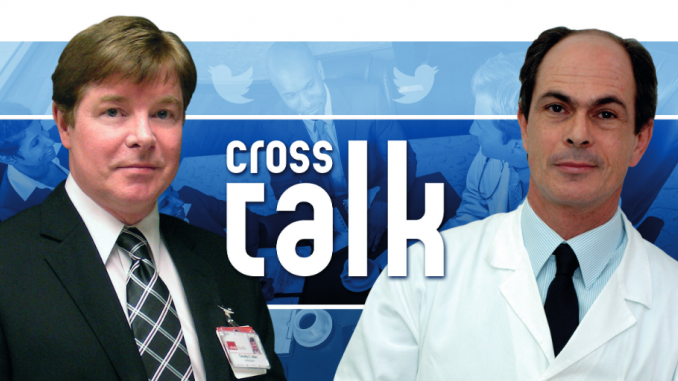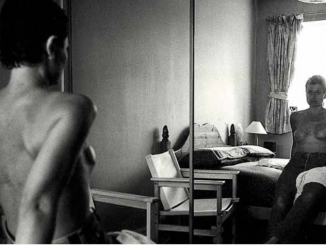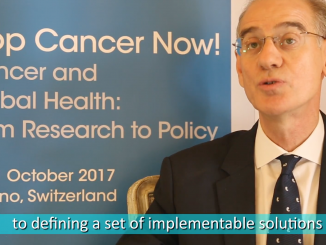
The complexity of cancer, the risks and benefits associated with alternative treatment options, the care needs of patients, all point to the need for input from specialists in many disciplines. But are regular face-to-face multidisciplinary team meetings the best way to achieve this?
The advantages of a multidiscipli¬nary approach to managing cancer patients are no longer seriously questioned, and were recently spelt out in a policy document endorsed by professional societies, patient groups and cancer insitutes (Eur J Cancer 50:475–480). The complexity of cancer, the risks and benefits associated with alternative treatment options, the care needs of patients, all point to the need for input from specialists in many disciplines. But are regular face-to-face multidisciplinary team meetings the best way to achieve this?
Tim Allen, a pathologist at the University of Texas Medica Branch, thinks not. In an article he co-authored last year (Nat Rev Clin Oncol 10:552– 554), he argues that tumour boards delay care, provide minimal patient benefit, don’t account for psychosocial issues and should be scrapped in favour of real-time decision making using social media. Under this system, suspected cases could be flagged up immediately using “standardised hashtag streams for cancer teams via Twitter”, and “all discussion regarding patient care would be integrated online with imaging systems… using protected Facebook-based discussion pages…”
Riccardo Valdagni, a radiation oncologist and leader of the Prostate Programme at the Istituto Nazionali dei Tumori in Milan, takes a different view. First author of a paper published in the European Journal of Cancer (2011, 47:1–7) defining the requirements of a specialist Prostate Cancer Unit, Valdagni believes that patients get better care when they are treated by teams that not only meet together but work as a unit, preferably at a single site.
Cancer World’s Anna Wagstaff asked Valdagni and Allen to see if they could find any common ground.
Tim Allen
 The idea of tumour boards has served us well but it is time to move on. Several articles have recently documented increasing delays between the diagnosis and the beginning of treatment. Having to make a patient wait a week or two for a tumour board to meet is just one of the things that is wrong with it. Then there is the cost: the direct costs of tumour boards are high, and to hold the meetings requires numerous personnel hours.
The idea of tumour boards has served us well but it is time to move on. Several articles have recently documented increasing delays between the diagnosis and the beginning of treatment. Having to make a patient wait a week or two for a tumour board to meet is just one of the things that is wrong with it. Then there is the cost: the direct costs of tumour boards are high, and to hold the meetings requires numerous personnel hours.
A lot of physicians have put the tumour board on a pedestal, and no-one wants to toy with it. But literature shows that it does not meet its own goals, which is to standardise and improve patient care.
The tumour board concept needs to be reshaped – its function shouldn’t be lost. Bryan Liang [co-author of the Nature Reviews Clinical Oncology article on Introducing Real Time to Oncology Management] and I propose using the internet for real-time communications between the various parties, including not only the clinicians, surgeons if necessary, pathology, and radiology, but also people with knowledge of the social/economic aspects of the patient, so we don’t reach a treatment decision that is inappropriate or unfeasible. Also the patients themselves can be integrated into the discussion to ensure their preferences are known and they are well aware of what is happening and why.
The basic idea is to get the patient’s diagnosis, correlate it with radiology, determine the stage, figure out the therapy, and institute that therapy as quickly as possible. The goal will be to do this in truly real time, or pretty close. Twitter (e.g. Group Tweet) has been suggested by us. It would have to be an internet vehicle with appropriate security.
Riccardo Valdagni
 Social media may respond to the need for rapid exchange of information, but in oncology, with few exceptions, speediness is not the main criterion for quality of care. In the case of prostate cancer, for instance, the decision-making process is complex, and the ‘right’ amount of time is required to finalise patients’ choice.
Social media may respond to the need for rapid exchange of information, but in oncology, with few exceptions, speediness is not the main criterion for quality of care. In the case of prostate cancer, for instance, the decision-making process is complex, and the ‘right’ amount of time is required to finalise patients’ choice.
We do need to find better ways to involve patients in multidisciplinary discussions about their treatment and care – the lack of patient input is one of the pitfalls of traditional tumour boards. However, as MIT Professor Sherry Turkle suggested in her 2012 book, the use of social media should not be confused with real communication. It can be very useful to exchange information, but it is not very likely to support a shared decision-making process and promote the engagement of the patient.
Taking again the example of prostate cancer, patients with localised disease often face the opportunity – and the burden – of choosing between two to four different options (surgery, external radiation therapy, brachytherapy, active surveillance), all equal in preserving their survival, but each with different physical, sexual, emotional and social consequences. The literature highlights that when patients are not involved in the decision-making process they are more likely to regret the decision to undergo a certain treatment and may wish they had chosen a different approach.
So patients need to be given information, but this is only the first step. The information has then to be acquired, understood and assessed from the patient’s perspective. To achieve this, discussing with the physician is paramount. A virtual environment may not be the ideal medium to help clinicians to take into account the patient’s perspective. We need to find multidisciplinary cost-effective organisational models that promote the patients’ engagement and a relationship based on mutual trust.
Tim Allen
 I agree that speed is not necessarily the most important thing. What we are trying to do is to remove the unnecessary loss of time so that all that is left is the appropriate time spent with patients in a very condensed or close to real-time fashion – less down time.
I agree that speed is not necessarily the most important thing. What we are trying to do is to remove the unnecessary loss of time so that all that is left is the appropriate time spent with patients in a very condensed or close to real-time fashion – less down time.
And there is certainly the issue of digesting the information, and understanding it. That’s why the person-to-person contact is so important, and it should continue and probably be expanded. But this real-time online model allows important decisions – the medical/therapeutic ones – to be made with the patient’s and family’s input, if they wish, along with the team’s input. Any personal communication or necessary patient involvement not only can occur, but should occur before during and after this process.
I completely support the concept not only of today’s idea of person-to-person engagement, but actually improved personal engagement with patients. It is vitally important for the entirety of the patient care, and should be emphasised even as we progress to the real-time multidisciplinary team approach. I would argue that using social media as a communication tool would actually permit more of that. At the moment patients don’t show up at tumour boards, families don’t show up at tumour boards, patients sit at home and worry, and that’s one of the things that the person-to-person engagement supplemented by a real-time multidisciplinary approach could improve.
In our model, the patient’s involvement starts as soon as they walk in the GP’s door – before a diagnosis of cancer has been made. Instead of the patient then going on and worrying and being out of the loop, which is often the case, this model portends a world in which the patient and family are involved every step of the way, if they want.
Riccardo Valdagni
 We can’t take it for granted that most patients have easy access to the web and adequate digital literacy to interact with physicians by using social media. It’s true that patients are increasingly approaching the internet, but interaction with social media platforms may be not as straightforward as with the internet browsers. Could we end up excluding patients even more, rather than including them in the care process?
We can’t take it for granted that most patients have easy access to the web and adequate digital literacy to interact with physicians by using social media. It’s true that patients are increasingly approaching the internet, but interaction with social media platforms may be not as straightforward as with the internet browsers. Could we end up excluding patients even more, rather than including them in the care process?
I’d also question whether the research really does show that tumour boards fail to improve patient care. Weak study design together with improperly identified outcomes and a large number of confounding variables make it impossible to draw clear-cut conclusions on the added value of multidisciplinary tumour board-based cancer management over the monodisciplinary approach. Also, let’s not forget that face-to-face tumour boards probably provide the best context to discuss clinical cases: each physician can contribute with their own expertise and continuous training is achieved. Cross-fertilisation of different specialist cultures is an asset, and a true team is something more than just a number of individuals digitally connected. Virtual communities are more and more common but members require more time to create steady ties based on mutual trust.
Furthermore, I don’t think we can just assume that holding ‘real-time’ discussions on every case, instead of dealing with them at regular scheduled meetings, will necessarily save clinicians any time. Will clinicians be expected to be ‘online’ all the time? We know from using Blackberries and smartphones that we are expected to be constantly on call – people expect immediate feedback. What is the impact on physicians likely to be? Will it increase the likelihood of clinician burnout? And last but not least, while medical professionals need to act, we also need time for reflection and self-reflection. Will the digital environment support that?
Tim Allen
 There may be patients who do not want to use social media, or are not comfortable with it. So this model has to take that into account and work with it. But there may also be patients who not only are very comfortable doing things in real time, internet fashion, but who actually demand it. And for some patients the idea of having to get up, drive several miles, and spend half a day hearing the same thing you’ll hear in 10 minutes online is not an option.
There may be patients who do not want to use social media, or are not comfortable with it. So this model has to take that into account and work with it. But there may also be patients who not only are very comfortable doing things in real time, internet fashion, but who actually demand it. And for some patients the idea of having to get up, drive several miles, and spend half a day hearing the same thing you’ll hear in 10 minutes online is not an option.
If you look at the West article that we built on [Practising in partnership with Dr Google, reprinted in Cancer World http://is.gd/ yo82ZQ], it describes patients who are pushing doctors and researchers to make better use of online internet-based medical communication. Patients are interested in using social media for their healthcare.
I agree there is not much research out there. But recent literature shows tumour boards aren’t working, and cutting out the down time would be of value even if they were. I would argue for more research, to assess and quantify the value of a real-time multidisciplinary team that I’m advocating for. We need to know how much time we are saving, not just that we are saving time. We need to hear from patients – are there things that we can alter to make it easier and better for them? Our idea is in its early stages, and it may be that it’s done differently in some places versus others, but there’s no overcoming the idea that in today’s world of telemedicine, taking care of patients in rural areas, the need to save time, the tumour board concept is frankly defunct and we need to utilise these teams that have been built from the tumour board mentality and make them function with an online platform with as much participation as the patient is interested in, so we can get answers quickly, get the patient treated quickly, provide better care and hopefully save money at the same time.
Riccardo Valdagni
 Research and clinical practice show that most patients want to be in charge of their health, but at the same time they want and need to rely on the professional, clinical expertise of physicians. Shared decision making is what we are talking about.
Research and clinical practice show that most patients want to be in charge of their health, but at the same time they want and need to rely on the professional, clinical expertise of physicians. Shared decision making is what we are talking about.
It’s true that one of the main pitfalls in traditional tumour boards is the lack of patients’ involvement. Patients should get the chance to sit down – face to face – with their GP or with a specialist (depending on how the healthcare system is organised) and discuss screening-related issues (in the case of prostate cancer), the effectiveness of different therapies, and potential treatment side-effects. Part of the discussion could address how far the patient wants to be involved in the decision-making process, and which media could be used to keep them engaged over time. Specific questions should be asked to assess who the patients share health-related decisions with, how self-confident they are at making choices, and whether they are familiar with social media if we want to tweet them information about their care process. You can’t just collect patients’ medical information and then tweet them therapeutic options. This applies to diagnosis as well as recurrence events.
I can see the potential value of using social media to connect the patients with the care team and connect clinicians among themselves. But before we invest in implementing social-media-based communication, we need to know what patients think about it. We should conduct pilot studies to define the pros and cons, and we should look at cost-related and medico-legal issues, and also address the questions: Does it really save time? Will clinicians be expected to be permanently ‘online’? Will it increase the likelihood of burnout?
The bottom line is that changes we make to the way decisions about treatment and care are made must demonstrate that they preserve the patient–physician(s) relationship which is the basis of the care (versus cure) path, and preserve a truly multidisiciplinary approach.





